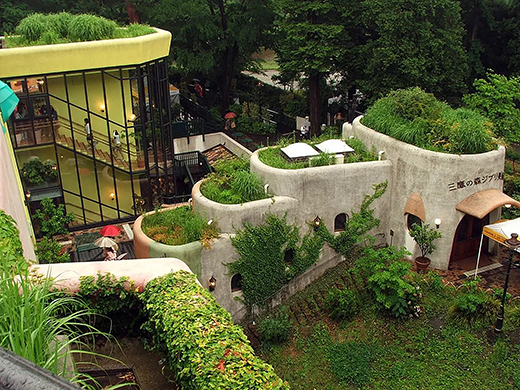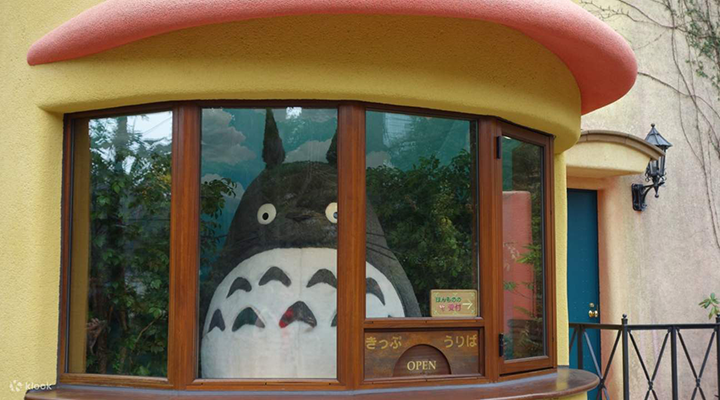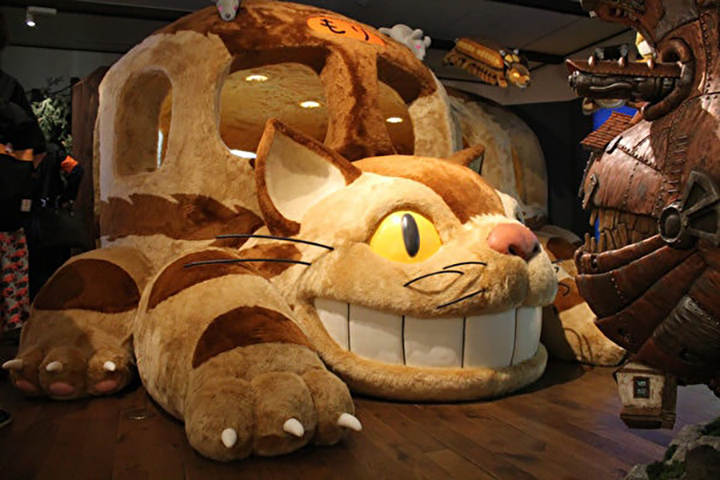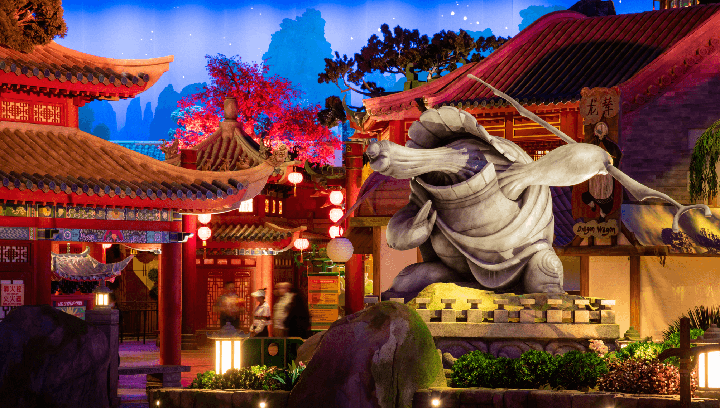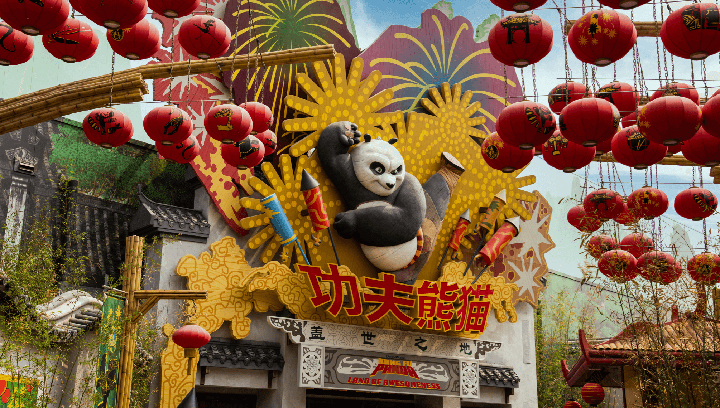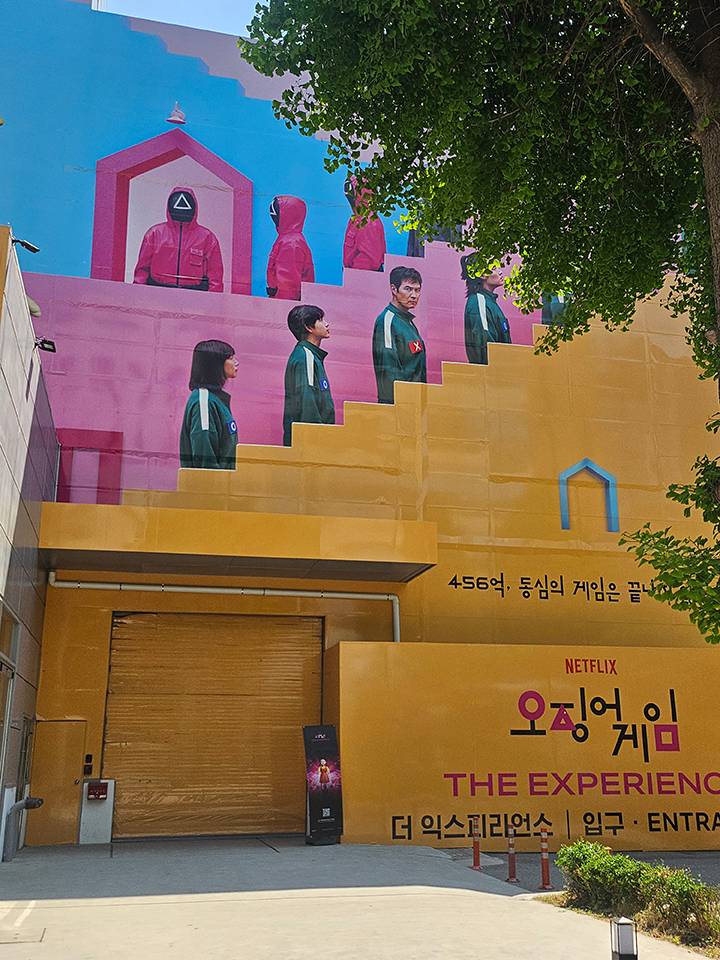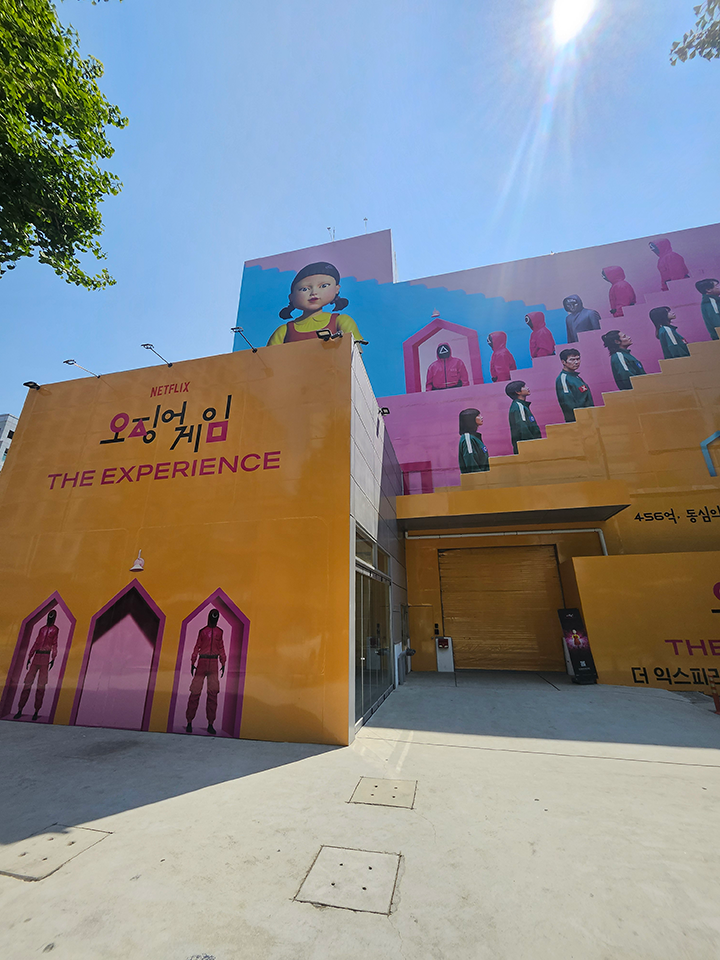디즈니랜드 없는 디즈니가 존재할 수 있을까? 어릴 때 TV로 처음 만난 디즈니 애니메이션의 오프닝은 디즈니랜드의 전경이었다. 애니메이션 속 미키 마우스, 도널드 덕, 피터 팬, 곰돌이 푸 등 모든 캐릭터를 디즈니에 가면 만날 수 있다고 믿었다. 사실이다. 이제는 미국만이 아니라 도쿄, 파리, 홍콩 등에 있는 디즈니랜드, 월드에 가면 TV와 극장에서 보았던 ‘판타지’를 체험할 수 있다.
애니메이션만이 아니다. 마블 시네마틱 유니버스를 직접 경험하고, 해리 포터의 마법을 시연하는 공간이 세계 곳곳에 있다. 디즈니랜드와 유니버설 스튜디오 등 영화를 기반으로 만든 공간 콘텐츠가 더욱 빠르게 성장하며 엔터테인먼트의 중심이 된 것이다. 극장에서 상영하는 영화를 넘어 영화의 세계관, 캐릭터, 스토리를 현실 공간에 구현해 팬에게 몰입감 높은 경험을 제공하고 있다. 미국의 디즈니와 워너, 일본의 지브리 등 열성적인 팬을 가진 영화사, 엔터테인먼트 회사들이 영화 기반 공간 콘텐츠를 어떻게 만들어 가는지 짚어보자.
‘보는 영화’를 넘어 ‘체험 콘텐츠’로
미야자키 하야오의 애니메이션 스튜디오 지브리는 도쿄에 지브리 미술관, 아이치현에 지브리 파크를 운영하고 있다. 2001년에 개관한 지브리 미술관은 미야자키 하야오와 다카하다 이사오가 연출한 지브리 애니메이션의 세계와 제작 과정을 깊이 있게 탐구하는 아기자기한 ‘박물관’이다. 보고 느끼면서 공감하는 자유로운 경험을 할 수 있다. 2022년에 문을 연 지브리 파크는 애니메이션의 세계를 실제 공간에 구현해, 작품 속 명장면이나 장소를 직접 거닐고 체험하며 생생함을 느끼는 몰입형 ‘테마 파크’다.
로스앤젤레스(LA)와 파리, 홍콩에 있는 마블의 어벤져스 캠퍼스는 쉴드의 신입 요원이 되어 어벤져스 멤버와 만나고, 스파이더맨의 웹 슈터로 스파이더 봇을 잡는 어트랙션과 핌 입자 기술을 활용한 음식 등 영화 설정을 기반으로 만들어진 공간에서 다양한 체험을 할 수 있다. 단순히 영화 속 장면을 재현하는 것을 넘어 직접 마블시네마틱유니버스(MCU)의 세계관에 들어가고, 자신만의 스토리를 만들어 갈 수 있다.
런던의 해리 포터 스튜디오는 영화 속 마법 세계를 현실로 옮겨놓은 듯한 장소다. 해리 포터가 호그와트로 출발하는 9와 3/4 승강장에서 기차를 배경으로 사진을 찍고, 빗자루를 타고 하늘을 나는 경험 등을 할 수 있다. 호그와트의 그레이트 홀, 덤블도어 교장실, 그리핀도르 기숙사 등도 재현되어 있다. 좋아하는 영화의 촬영 세트와 소품들을 보는 재미도 각별하지만 해리 포터 스튜디오의 강점은 직접 호그와트에 들어와 있는 듯한 생생한 체험이다.
디즈니랜드의 강력한 경쟁자 유니버설 스튜디오는 매우 공격적이다. 유니버설은 지식재산권(IP)으로 확장할 자체 콘텐츠가 적다. 대신 해리 포터, 트랜스포머, 스파이더맨, 미니언, 포켓몬 등 대중적인 IP를 많이 가져와서 어필하는 전략이었다. 그중 유니버설 스튜디오 베이징의 IP 콘텐츠 전략은 눈여겨볼 필요가 있다. 인지도가 높은 할리우드 IP와 중국 현지인에게 매력적인 중국 IP를 효과적으로 결합한다. 서구 문화 콘텐츠에 익숙한 젊은 세대부터 자국 문화에 대한 자부심을 가진 폭넓은 연령층까지 만족시키려는 시도다.
유니버설 스튜디오 베이징은 할리우드 블록버스터 영화 기반의 ‘위저딩 월드 오브 해리포터’, ‘트랜스포머 메트로베이스’, ‘쥬라기 월드: 누블라 섬’, ‘미니언 랜드’ 구역 등이 인기다. 주목할 구역은 ‘쿵푸팬더: 랜드 오브 어썸니스’다. 중국 문화를 배경으로 중국의 대표 캐릭터 팬더가 나오는 드림웍스 애니메이션 <쿵푸 팬더>는 중국인에게 친숙하고 인기 좋은 콘텐츠다. 베이징에만 존재하는 테마 구역 ‘쿵푸팬더: 랜드 오브 어썸니스’는 영화 속 공간을 재현하고, 쿵푸 팬더를 테마로 만든 공연과 식음료 등으로 특별한 경험을 선사한다. 할리우드의 강력한 스토리텔링과 기술력을 바탕으로 한 글로벌 IP와 중국 문화의 매력을 담은 현지 IP를 성공적으로 융합한 대표적인 사례다. 글로벌 엔터테인먼트 회사가 특정 국가에 진출할 때 현지화 전략을 어떻게 세워야 하는지 잘 보여준다.
유니버설이 IP를 잘 골라서 지역마다 대표 상품을 만들어낸다면, 디즈니는 자사의 풍부한 IP를 파고들어 확산시키는 방식을 택한다. 2010년 개봉한 <라푼젤>은 디즈니의 새로운 전성기를 알리는 작품이었다. 백설공주, 인어공주 등 익숙한 동화 속 공주의 이미지를 깨고 능동적이며 활발한 성격의 라푼젤을 내세웠다. 전 세계 수익이 6억 달러를 넘으며 흥행에서 성공을 거두었고, 비평가와 관객의 평가도 우수했다. 이후 디즈니는 미래지향적인 캐릭터 ‘라푼젤’을 다방면으로 확장했다. 단편 <라푼젤 그 후 이야기>(2012)가 만들어졌고, 2017년부터 디즈니 채널에서 <라푼젤 시리즈>(2017~2020)가 방영되었다. 도쿄 디즈니씨의 ‘판타지 스프링스’에는 ‘라푼젤의 숲’ 구역이 만들어졌다. 어트랙션과 레스토랑이 있고, 라푼젤 캐릭터는 곳곳을 돌아다니며 관객과 어울리고 퍼레이드에도 참여한다. 디즈니 크루즈 라인에서 라푼젤 뮤지컬 공연을 하고, 디즈니 관련 게임에도 라푼젤이 등장한다. 다양한 상품으로 만들어지는 디즈니 프린세스 라인업에 라푼젤이 추가된 것도 당연한 일이다.
도쿄 지브리 미술관
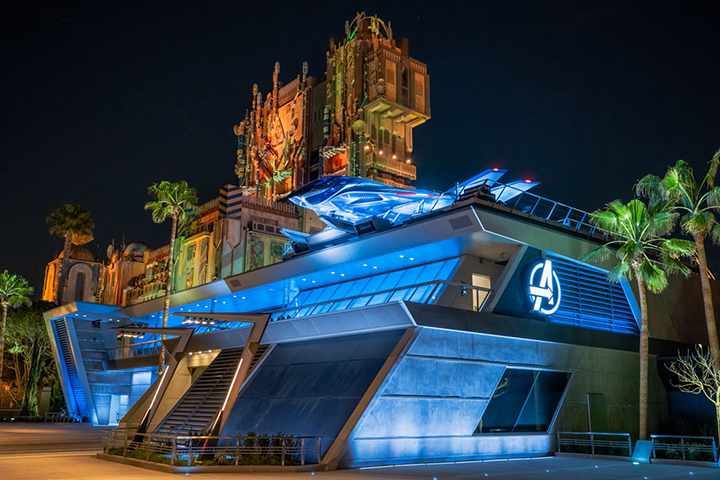
로스앤젤레스(LA)와 파리,
홍콩에 있는 마블의 어벤져스 캠퍼스
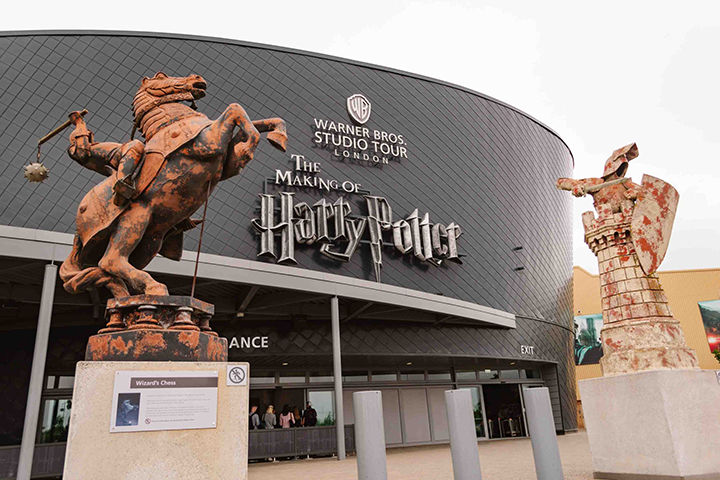
런던 워너 브라더스 스튜디오의
'더 메이킹 오브 해리포터'
베이징 유니버셜 스튜디오의 ‘쿵푸팬더: 랜드 오브 어썸니스’
도쿄 디즈니씨의 ‘판타지 스프링스’의 ‘라푼젤의 숲’
팬덤과 경험이 주도하는 엔터테인먼트 산업
지금 대중문화 트렌드의 핵심은 경험과 팬덤이다. 영화, 애니메이션, 게임 등은 일종의 환상이지만 팬은 현실에서 직접 경험하고 이야기에 참여하기를 바란다. 과거의 테마파크가 영화의 IP를 활용한 어트랙션과 약간의 부가 스토리를 제공했다면, 이제는 세계관을 확장해 관객이 직접 ‘스토리’에 참여해 ‘캐릭터’를 체험하게 한다. 팬으로서 최고의 경험은, 보고 듣는 것을 넘어 주인공과 함께 스토리에 참여하는 것이다.
팬들은 자신이 좋아하는 영화의 세계를 방문하고 체험하며, 영화 속 인물이 된 느낌을 원한다. 가상현실(VR) 어트랙션, 증강현실(AR) 애플리케이션을 활용한 공간 탐험, 정교하게 움직이는 애니매트로닉스 캐릭터를 이용한 테마 공간이 주목받는 이유다. 도시 번화가에서 운영되는 몰입형 전시·체험 공간, 특정 기간만 운영하는 팝업 스토어·카페, 영화 상영과 연극적 요소를 결합한 비밀 영화관(Secret Cinema) 등 새로운 형태의 공간 콘텐츠도 활발하게 운영되고 있다. 또한 강력한 팬덤은 단지 개인의 경험만이 아니라 다른 팬들과 교류하며 커뮤니티 의식을 강화하기를 요구한다. 소셜미디어를 통해 경험을 공유하고 확산시키며, ‘인생샷’을 찍을 수 있는 포토 스폿의 중요성도 커지고 있다. 팬들의 경험 공유는 공간 콘텐츠의 홍보에도 크게 기여한다.
강력한 스토리텔링과 시각적 요소가 뛰어난 영화 IP일수록 공간 콘텐츠로서의 잠재력이 뛰어나다. 과거의 단편적인 상품 출시나 단순한 테마 구역 조성을 넘어, IP 세계관 자체를 확장하고 팬들에게 몰입도 높은 경험을 제공하는 방향으로 나아가고 있다. 영화사에 새로운 수익 모델이 되는 공간 콘텐츠는 하나의 새로운 상품 개발을 넘어 엔터테인먼트 산업의 지평을 넓히고 있다. 온라인과 오프라인 경험을 연계하며, 디지털 플랫폼(게임, 스트리밍, 앱)과 물리적인 공간(테마파크, 팝업 스토어, 체험 전시) 간의 경계도 희미해질 것이다. 열광적인 팬들은 IP의 수동적인 소비자를 넘어 능동적으로 경험을 만들어 가고 커뮤니티에 참여하는 주체가 될 것이다. 공간 콘텐츠의 인기로 예상할 수 있는 IP 확장의 미래는 더욱 몰입적이고, 개인화하며, 온·오프라인이 유기적으로 연결된 경험을 제공하는 방향으로 나아갈 것이다.
한국영화 IP의 미래
아직까지 한국 영상 콘텐츠를 활용한 테마파크는 많지 않다. 국내에서 시대극을 찍을 때 사용한 세트장이나 로케이션 장소 등이 관광지로 쓰이는 정도다. 디즈니랜드와 유니버설 스튜디오처럼 특정 영화의 팬을 상시적으로 끌어들이는 테마 공간이 부족하다.
현재 한국의 영상 콘텐츠는 세계적으로 인기가 있다. 넷플릭스 시청 세계 순위에서 미국 다음으로 한국 콘텐츠가 가장 많은 시청자를 확보하고 있다. 히트작과 수작도 끊이지 않는다. <오징어 게임>과 <킹덤> 같은 스펙터클한 스릴러, 액션만이 아니라 <이상한 변호사 우영우><폭삭 속았수다> 등 스토리텔링이 돋보이는 작품들도 인기를 끌고 있다. 위기는 늘 있으나 한국 영상 산업의 경쟁력은 여전히 뛰어나고, 해외의 팬들도 여전히 많고 확고하기에 미래의 가능성은 크다.
한국 영상 콘텐츠 중에서 확장될 가능성이 큰 IP는 무엇이 있을까? 넷플릭스 흥행작인 <오징어 게임>은 글로벌 IP로서의 경쟁력을 입증했다. 극한의 서바이벌 게임이라는 직관적인 설정과 강렬한 비주얼은 다양한 확장 가능성이 있다. 이미 만들어진 현실판 게임 이벤트나 리얼리티 쇼, 체험형 팝업 스토어가 있다. VR·AR 게임도 가능하며, 공간 콘텐츠로 확장된다면 가족형 테마파크보다는 성인 대상의 몰입형 서바이벌 게임이 될 수 있다. <오징어 게임>의 공간은 미술적인 완성도가 높아 실제 공간으로 옮긴다면 충분히 팬들을 매혹시킬 수 있을 것이다. 서바이벌 게임을 즐기는 체험도 가능하고,
‘조선 좀비’ 시리즈 <킹덤>은 좀비가 출몰하는 조선 궁궐과 마을 등의 공간 콘텐츠가 가능하고 좀비와의 추격전을 어트랙션으로 만들 수 있다. 액션 RPG 게임 등으로 확장도 가능할 것이다. 좀비 아포칼립스라는 보편적인 소재가 언제나 인기 있기에, <부산행>의 KTX와 기차역을 활용한 공간 콘텐츠도 가능하지 않을까? VR·AR 기반의 좀비 서바이벌 게임, 시리즈 리메이크·스핀오프 확장도 있고.
IP의 확장은 보편적이며 스펙터클한 소재만이 아니라 작품 자체의 명성에도 크게 좌우된다. 그런 점에서 봉준호의 <기생충>은 기이한 반지하 집과 화려한 부잣집 저택의 분리된 위와 아래 공간을 이용한 몰입형 체험 전시, 지하에서의 탈출을 가상한 이스케이프 룸 등으로 확장할 수 있을 것이다. 요컨대 IP의 확장은 오리지널의 매력이 클수록 가능하고, 캐릭터와 스토리의 확장 가능성이 중요하다.
지금은 극장 수익이 줄어들면서 전체적인 엔터테인먼트 산업의 지형도가 변화하는 상황이다. 새롭게 만들어지는, 그리고 이미 알려진 IP의 가치를 극대화하는 것은 한국 엔터테인먼트 산업의 새로운 동력이 될 수 있을 것이다.
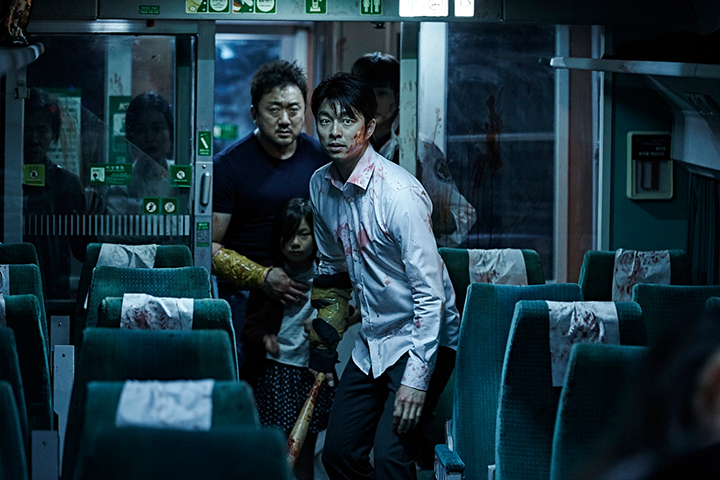
<부산행> KTX 열차 내부 장면
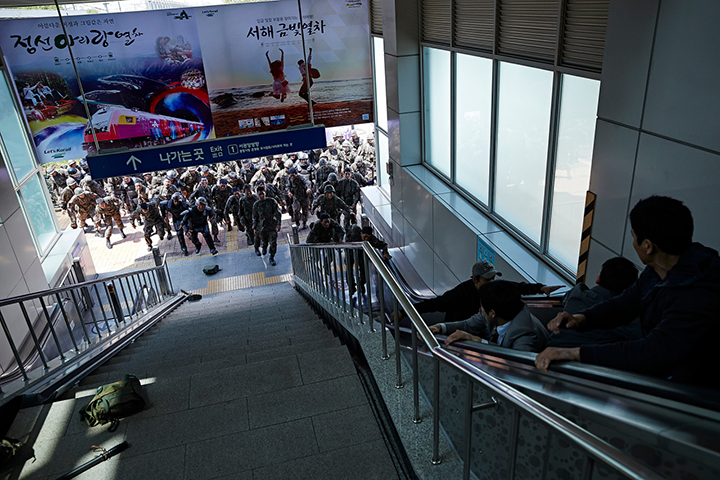
<부산행> 속 기차역사 안 좀비 습격 장면
뉴욕, 마드리드, 시드니에 이어 서울에도 열린
몰입형 체험 공간 '오징어 게임 : 더 익스피리언스'
공간콘텐츠
IP확장
체험형콘텐츠
테마파크
영화IP
글로벌IP
GLOBAL
From the Ghibli Museum
to the Marvel Campus
How IP Movies Are Evolving into Spatial Contents
By Kim Bong-seok (Film Critic)
2025-05-02
Can Disney exist without Disneyland? The opening sequence of the Disney animations I first watched on TV as a child featured a panoramic view of Disneyland. I believed I could meet all the characters from the animations — Mickey Mouse, Donald Duck, Peter Pan, Winnie the Pooh — at Disney. And that belief turned out to be true. Today, not only in the United States but also in Tokyo, Paris, and Hong Kong, you can experience the fantasy worlds once seen on TV and in theaters by visiting Disneyland or Disney World.
This phenomenon isn't limited to animation. There are places around the world where you can step directly into the Marvel Cinematic Universe or witness the magic of Harry Potter. Space-based content like Disneyland and Universal Studios, built around movies, has rapidly grown to become the centerpiece of modern entertainment. Moving beyond films shown in theaters, these spaces bring movie universes, characters, and stories into the real world, offering fans highly immersive and engaging experiences. In this article, we’ll take a closer look at how major film and entertainment companies with passionate fan bases — such as Disney and Warner in the U.S., and Ghibli in Japan — are creating movie-based spatial content.
Going Beyond “Watching Movies” to “Experiencing Content”
Hayao Miyazaki’s animation studio, Ghibli, operates both the Ghibli Museum in Tokyo and Ghibli Park in Aichi Prefecture. Opened in 2001, the Ghibli Museum is a charming space that offers an in-depth exploration of the Ghibli world and production processes behind Ghibli animations directed by Hayao Miyazaki and Isao Takahata. It provides a free-flowing and immersive experience where visitors can see, feel, and connect emotionally with the studio’s creations. Ghibli Park, which opened in 2022, is an immersive theme park that brings Ghibli animations into real-life spaces, allowing visitors to walk through iconic scenes and settings from the films and experience their magic firsthand.
Meanwhile, the Avengers Campus, located in Los Angeles, Paris, and Hong Kong, offers a variety of experiences based on the Marvel movie universe. Visitors can become rookie S.H.I.E.L.D. agents, meet Avengers members, catch Spider-Bots using Spider-Man’s web shooters, and enjoy food crafted with Pym Particle technology — all within spaces designed to bring the cinematic world to life. It goes beyond simply recreating scenes from the movies, enabling visitors to step directly into the Marvel Cinematic Universe (MCU) and create their own stories.
The Harry Potter Studio in London feels like a place where the magical world of the film franchise has been brought to life. At Platform 9¾, where Harry Potter departs for Hogwarts, visitors can take photos with the train as a backdrop and experience the sensation of flying through the sky on a broomstick. Iconic locations such as the Hogwarts Great Hall, Dumbledore’s office, and the Gryffindor common room have also been faithfully recreated. While seeing the sets and props from these beloved films is a special treat, the true strength of the Harry Potter Studio lies in its vivid, immersive experience that makes you feel as if you’ve stepped right into Hogwarts.
Disneyland’s powerful rival, Universal Studios, takes a far more aggressive approach. Universal has relatively few original intellectual properties (IPs) of its own to expand upon. Instead, it has pursued a strategy of acquiring and featuring popular IPs such as Harry Potter, Transformers, Spider-Man, Minions, and Pokémon to attract audiences. Among these, the IP content strategy of Universal Studios Beijing is particularly noteworthy. The park effectively blends globally recognized Hollywood IPs with Chinese IPs that resonate with local audiences. This approach seeks to satisfy a broad range of visitors — from younger generations familiar with Western pop culture to older audiences who take pride in their own cultural heritage.
At Universal Studios Beijing, zones based on Hollywood blockbusters such as The Wizarding World of Harry Potter, Transformers: Metrobase, Jurassic World: Isla Nublar, and Minion Land are especially popular. One standout zone is Kung Fu Panda: Land of Awesomeness. The Kung Fu Panda series from DreamWorks Animation, set against the backdrop of Chinese culture and featuring the iconic panda character, is a familiar and beloved piece of content among Chinese audiences. Exclusive to Beijing, Kung Fu Panda: Land of Awesomeness recreates the film’s setting and offers a unique experience through themed shows, food, and beverages. It serves as a prime example of how global IPs, founded on Hollywood’s powerful storytelling and technological prowess, can successfully blend with the cultural appeal of locally rooted Chinese IP. It clearly demonstrates how global entertainment companies should craft effective localization strategies when entering specific national markets.
While Universal carefully selects IPs to create signature attractions tailored to each region, Disney takes a different approach: expanding deeply into its rich library of IPs. Released in 2010, Tangled marked the beginning of a new golden era for Disney. Breaking away from the familiar portrayals of fairy tale princesses like Snow White and The Little Mermaid, Tangled introduced Rapunzel as an active, energetic, and independent character. With global earnings exceeding USD 600 million, the film was a commercial success and received high praise from both critics and audiences. Since then, Disney has expanded Rapunzel’s forward-looking character across various platforms and formats. The short film Tangled Ever After (2012) was produced, followed by the animated TV series Rapunzel’s Tangled Adventure (2017–2020), which aired on Disney Channel. A dedicated area called Rapunzel’s Forest was created at Tokyo DisneySea’s Fantasy Springs, featuring attractions and a themed restaurant, with the Rapunzel character roaming the area to interact with guests and participating in parades. Rapunzel also appears in musical performances aboard Disney Cruise Line and features in various Disney-related games. Naturally, she was added to the Disney Princess lineup, which spans a wide range of merchandise.
Ghibli Museum, Tokyo

Marvel’s Avengers Campus in Los Angeles (LA), Paris, and Hong Kong

'The Making of Harry Potter' at Warner Bros. Studio London
'Kung Fu Panda: Land of Awesomeness' at Universal Studios Beijing
'Rapunzel’s Forest' in Fantasy Springs at Tokyo DisneySea
Entertainment Industry Driven by Fandom and Experience
At the heart of today’s pop culture trends are experience and fandom. While movies, animations, and games are rooted in fantasy, fans increasingly seek firsthand experiences that allow them to become part of the story in the real world. In the past, theme parks offered attractions inspired by movie IPs with limited storytelling elements. Today, they expand entire universes, enabling visitors to actively participate in the narrative and immerse themselves in the characters. For fans, the ultimate experience goes beyond merely watching and listening — it involves stepping into the story alongside the main characters.
Fans crave the opportunity to visit and experience the worlds of their favorite films, longing for the feeling of becoming a character within the story. This is why VR attractions, AR-based spatial explorations, and theme zones featuring highly sophisticated animatronic characters are gaining popularity. New forms of spatial content are also rapidly emerging, including immersive exhibitions and experience spaces located in bustling city centers, limited-time pop-up stores and cafés, and hybrid formats like Secret Cinema, which combine film screenings with theatrical performances. Moreover, a strong fandom seeks more than just individual experiences — it desires connection with other fans, reinforcing a sense of community and shared identity. Sharing and spreading experiences through social media has become crucial, making photo spots where fans can capture their “once-in-a-lifetime shots” increasingly important. These shared moments significantly contribute to the promotion and viral spread of spatial content.
The stronger the storytelling and visual elements of a film IP, the greater its potential as spatial content. The industry is moving beyond fragmented merchandise releases or basic themed zones toward expanding the IP’s universe itself and offering fans deeply immersive experiences. Spatial content, now emerging as a new revenue model for film studios, represents more than just the development of new products — it expands the very horizons of the entertainment industry. As online and offline experiences become increasingly interconnected, the boundaries between digital platforms — such as games, streaming services, and apps — and physical spaces — like theme parks, pop-up stores, and interactive exhibitions — will continue to blur. Passionate fans are evolving beyond passive consumers of IP; they are becoming active creators of experiences and engaged participants in fan communities. With the growing popularity of spatial content, the future of IP expansion is likely to move toward experiences that are even more immersive, personalized, and seamlessly integrated across both online and offline platforms.
The Future of Korean Film IP
There are still relatively few theme parks that leverage Korean visual content. For now, most efforts involve repurposing historical drama sets or filming locations as tourist attractions. Unlike Disneyland or Universal Studios, Korea lacks permanent themed spaces that consistently draw fans of specific films.
Korean visual content is currently enjoying global popularity, ranking second only to the U.S. in global viewership on Netflix. Hit titles and critically acclaimed works continue to emerge. In addition to spectacular thrillers and action series like Squid Game and Kingdom, story-driven works such as Extraordinary Attorney Woo and When Life Gives You Tangerines are resonating widely with audiences. Challenges certainly remain, but the Korean visual content industry remains highly competitive. With a strong and loyal international fan base, the future holds tremendous potential.
Which Korean visual content IPs have the greatest potential for expansion? The Netflix hit Squid Game has already proven its strength as a global IP. Its intuitive premise of extreme survival games and striking visual style offers vast opportunities for expansion. Real-life game events, reality shows, and immersive pop-up stores inspired by the series have already been created. VR and AR adaptations are also highly feasible. If developed into spatial content, Squid Game would likely take the form of an immersive survival experience targeted at adults rather than a family-oriented theme park. Its artistically crafted visual environments could easily captivate fans if recreated in the real world, offering immersive experiences where visitors actively participate in survival-style games.
The “Joseon zombie” series Kingdom also lends itself well to spatial content, with its settings of palaces and villages overrun by the undead. Chase scenes with zombies could be transformed into thrilling attractions, and the story could be expanded into formats like action RPG games. Given the enduring popularity of the zombie apocalypse genre, spatial content based on Train to Busan — featuring KTX trains and train stations — also holds strong potential. This IP could further expand into VR/AR-based zombie survival experiences, along with possibilities for remakes or spin-off series.
The expansion potential of an IP depends not only on the universality or spectacle of its themes but also heavily on the reputation and acclaim of the original work. In that sense, Bong Joon-ho’s Parasite holds strong potential for immersive expansion. Experiences such as exhibitions recreating the stark contrast between the semi-basement home and the luxurious mansion, or escape rooms simulating a dramatic flight from the basement, could effectively bring the film’s world to life. Ultimately, the stronger the appeal of the original IP, the greater its expansion potential — and the ability to extend its characters and storyline is the critical key.
With theater revenues declining, the overall landscape of the entertainment industry is undergoing significant change. Maximizing the value of both newly created and well-established IPs could become a powerful new growth engine for the Korean entertainment industry.

Inside the KTX Train in Train to Busan

Zombie Attack Scene at the Train Station in Train to Busan
"Squid Game: The Experience"
– Now in Seoul after New York, Madrid, and Sydney


